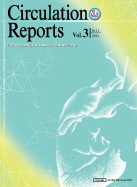3 巻, 11 号
選択された号の論文の13件中1~13を表示しています
- |<
- <
- 1
- >
- >|
Original Articles
Arrhythmia/Electrophysiology
-
原稿種別: ORIGINAL ARTICLE
専門分野: Arrhythmia/Electrophysiology
2021 年 3 巻 11 号 p. 629-638
発行日: 2021/11/10
公開日: 2021/11/10
[早期公開] 公開日: 2021/10/16PDF形式でダウンロード (3440K) HTML形式で全画面表示
Cardiac Rehabilitation
-
原稿種別: ORIGINAL ARTICLE
専門分野: Cardiac Rehabilitation
2021 年 3 巻 11 号 p. 639-646
発行日: 2021/11/10
公開日: 2021/11/10
[早期公開] 公開日: 2021/10/06PDF形式でダウンロード (2539K) HTML形式で全画面表示
Heart Failure
-
原稿種別: ORIGINAL ARTICLE
専門分野: Heart Failure
2021 年 3 巻 11 号 p. 647-653
発行日: 2021/11/10
公開日: 2021/11/10
[早期公開] 公開日: 2021/09/29PDF形式でダウンロード (1071K) HTML形式で全画面表示 -
原稿種別: ORIGINAL ARTICLE
専門分野: Heart Failure
2021 年 3 巻 11 号 p. 654-659
発行日: 2021/11/10
公開日: 2021/11/10
[早期公開] 公開日: 2021/10/05PDF形式でダウンロード (837K) HTML形式で全画面表示 -
原稿種別: ORIGINAL ARTICLE
専門分野: Heart Failure
2021 年 3 巻 11 号 p. 660-665
発行日: 2021/11/10
公開日: 2021/11/10
[早期公開] 公開日: 2021/10/15PDF形式でダウンロード (612K) HTML形式で全画面表示
Imaging
-
原稿種別: ORIGINAL ARTICLE
専門分野: Imaging
2021 年 3 巻 11 号 p. 666-673
発行日: 2021/11/10
公開日: 2021/11/10
[早期公開] 公開日: 2021/10/01PDF形式でダウンロード (1375K) HTML形式で全画面表示
Obesity
-
原稿種別: ORIGINAL ARTICLE
専門分野: Obesity
2021 年 3 巻 11 号 p. 674-681
発行日: 2021/11/10
公開日: 2021/11/10
[早期公開] 公開日: 2021/10/05PDF形式でダウンロード (1120K) HTML形式で全画面表示
Images in Cardiovascular Medicine
-
原稿種別: IMAGES IN CARDIOVASCULAR MEDICINE
2021 年 3 巻 11 号 p. 682-683
発行日: 2021/11/10
公開日: 2021/11/10
[早期公開] 公開日: 2021/09/23PDF形式でダウンロード (769K) HTML形式で全画面表示 -
原稿種別: IMAGES IN CARDIOVASCULAR MEDICINE
2021 年 3 巻 11 号 p. 684-685
発行日: 2021/11/10
公開日: 2021/11/10
[早期公開] 公開日: 2021/09/23PDF形式でダウンロード (1116K) HTML形式で全画面表示 -
原稿種別: IMAGES IN CARDIOVASCULAR MEDICINE
2021 年 3 巻 11 号 p. 686-687
発行日: 2021/11/10
公開日: 2021/11/10
[早期公開] 公開日: 2021/10/08PDF形式でダウンロード (767K) HTML形式で全画面表示
Letters to the Editor
-
原稿種別: LETTER TO THE EDITOR
2021 年 3 巻 11 号 p. 688-
発行日: 2021/11/10
公開日: 2021/11/10
[早期公開] 公開日: 2021/10/14PDF形式でダウンロード (299K) HTML形式で全画面表示 -
原稿種別: AUTHOR’S REPLY
2021 年 3 巻 11 号 p. 689-
発行日: 2021/11/10
公開日: 2021/11/10
[早期公開] 公開日: 2021/10/14PDF形式でダウンロード (302K) HTML形式で全画面表示
-
2021 年 3 巻 11 号 p. Content11-
発行日: 2021/01/10
公開日: 2021/11/10
PDF形式でダウンロード (653K)
- |<
- <
- 1
- >
- >|
